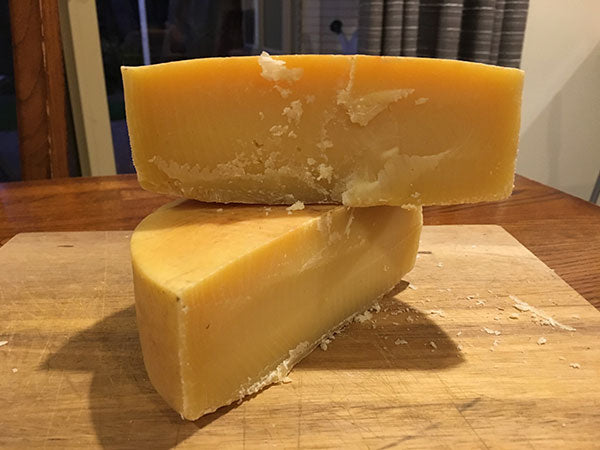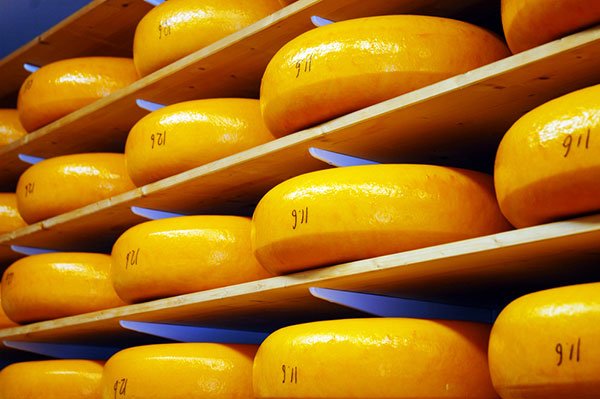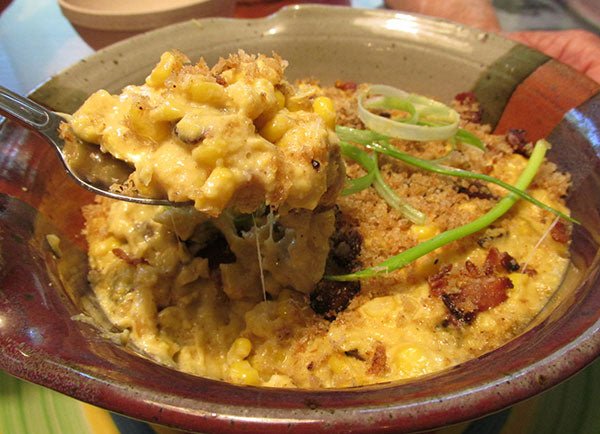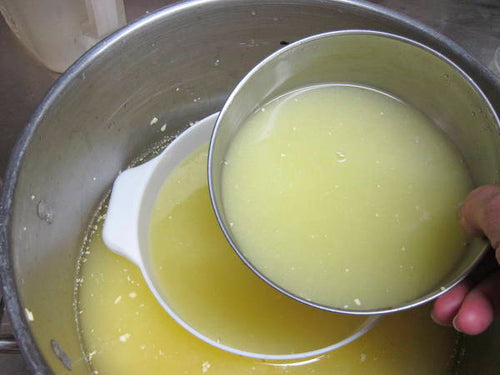Australia is a country where raw milk of any kind is simply illegal to sell. Fortunately, it is possible to make fabulous cheese from pasteurized milk if you know what you’re doing, and Rob Goris certainly does. He’s what we refer to as a “master” home cheese maker and it was an honor to interview him.
Rob Goris

With a few of my cheeses. From left to right: Washed rind, wine infused, Stilton & Camembert
I currently live in outer Sydney with my partner Leanne and our 3 kids. As a father, it’s always been important to me to teach kids how to live a sustainable life. We all enjoy gardening, fishing, baking and cheese making. My partner and I both have professional jobs in the city, but coming home to space and surrounded by bush (forest) is just what’s needed to recharge.

Left to right: Leanne, Maddie, Ollie and Eddie

With my sons, fishing in Brisbane Waters (saltwater estuary)

A beautiful silver Trevally

Eddie with a cauliflower from his garden
Before cheese making, I used to play chess competitively. I got into the top 30 in Australia. I delight in the shift to cheese being just a couple of letters away – chess to cheese.
I am a graphic designer by trade so I think both chess and cheese accommodate creativity. I’m also passionate about the environment and science and again these fit nicely with cheese.

Yes, that is Will Studd on the right. Last month, I attended a wine and cheese evening with Australia’s leading cheese authority.
How did you get started making cheese?
I first started cheese making with a small Italian cheese kit (mozzarella, ricotta and feta) that I got for my birthday. I had also just purchased Ricki’s famous book (Home Cheese Making). I was hooked. I have always liked things that use only a few ingredients and have so many possibilities, where skill and understanding can produce such a wide variety of outcomes. Beer and bread making fit into that slot, too.
I did a 1 day cheese course at a local hall. The course was run by two Spanish guys, one of whom had grown up in Switzerland and learned his cheese making skills there. They were both professionals who had moved to a life on the farm. In this course we learned how to make Camembert, mozzarella, yoghurt and whey ricotta. We learnt a lot about hygiene, liquid starter cultures and moulds.
The cheeses were incredible! I purchased their biggest cheese kit and off I went on my cheese journey. Some months later they offered a more advanced cheese making course which went for 2 days. We made brie, Caerphilly and feta. They all turned out well.
From there, I used books and the cheesemaking.com site as my main sources for recipes. I purchased all the international cheeses I could find and would compare them to my versions. I would bring my newly made cheeses into work and have my French work mate sample them.
When I got them right, he was clearly impressed (and would tell me when they weren’t so good). I’m now at the stage where I’m looking at things more scientifically and really trying to broaden my understanding of the vast varieties of moulds and yeasts out there. I’m partly forced into this area as raw milk is pretty hard to come by here.
So, like many cheese makers, it’s an ongoing learning journey – failures and successes along the way. (And, the search for a friend with either a cow or goat!)
What cheese do you make the most?
Leiden (Gouda with cumin seeds). I have a Dutch background so this is both a nostalgic cheese and a family favourite. My kids love it.

Leiden cheese, known in Holland as ‘Komijnekaas’
Blue (Stilton mainly), as it’s a crowd pleaser and one that is consistently good.


Eddie with a Stilton
Halloumi and feta are also big in our house. Australians love their BBQs and we have a nice mix of Greek, Italian and other Mediterranean people living here so we enjoy their food as it suits our climate.

Summertime means halloumi cheese. And a very smooth ricotta from the whey. I always prefer the more rustic approach and use fresh mint in between which I fold closed. So delicious. Some of this is destined for a halloumi and eggplant Turkish pide burger.
Halloumi and sometimes mozzarella on our pizzas. My son goes nuts for chips (fries) with crumbled feta and dried oregano on it. That’s a pure Greek thing. My young 8 year old daughter loves the ‘stinky’ cheeses most of all, but these don’t always work out.

Maddie making Mozzarella

Ollie, making quick Mozzarella
I look back and recall my father driving through a small New Zealand town called Mercer and stopping at a small cheese maker there. He was a one man business back then, had a Dutch background and mainly made goudas. Today, some 30 years later, he is a very successful cheese maker. His real strengths are his goudas and alpine cheeses. These are of the very highest standard – probably better than ones from Holland as the cows have access to those premium New Zealand pastures and weather.
I could go on with these stories… but in a way they kind of made me become a cheese maker. I was surrounded by self sufficient people when young and I guess you follow in their footsteps.

Soft washed rind
What do you use for a cave?
I use 2 wine fridges. However, given our very hot summers here it makes it difficult to keep cheese good in those fridges (even in an air conditioned house). My next purchase will be a fridge controlled with the additional temperature control extension. I’d like to get wooden shelves in it. I look forward to the day I can make better Alpine cheeses with greater temperature control.
I tend to be limited in the cheeses I make in summer – cheeses like Leiden can go straight into the normal fridge (although I do give them a couple of months in the wine fridge). Halloumi doesn’t last long in our house and can be eaten straight away.
What are your plans for the future?
At some stage, I hope to take cheese making to another level because there’s a lot of scope here in Australia to sell cheese. We are beginning to wake up to a world that looks beyond cheddar and Brie.
The biggest challenge is the government red tape here. One fellow cheese maker costed it up as being well over a million dollars to setup and be legal. That’s hard to do when raising kids. Another possibility is teaching cheese at farm stays. It’s a real chance to add something to the usual farm stay.

From left to right: Shropshire blue, Saint Marcellin, Cheddar and Bel Pease

Bleu de Gex (top), Leiden (left), Gouda (right), Caerphilly (bottom)
Do you have any advice for beginners?
Most books suggest keeping a diary, starting out on simple quick cheeses, only using the freshest milk and making sure all working surfaces have been sanitized etc, etc. That’s fine and good advice but I would suggest new cheese makers think about the overall objective of the cheese. This is something no book really covers, but if you know this you are better placed to assess how you are progressing.
For example, blue cheese, where the main objective is to create a curd that allows gaps for blue mould to develop but is moist enough to develop a paste. If you take this as the starting point, you can explore the variety of blues to see how this same objective is achieved in different ways. Knowing this means pressing a blue should be carefully considered as you don’t want to close those gaps or lose too much moisture.
Another great group of cheeses are the washed curd cheeses. Here the objective is to create a springy mild tasting cheese by washing the curds with water. The playing field is clear here – do you use hot, cold or same temperature water? Hot shrinks the curds and makes a firmer cheese while cool water swells the curds. It’s all there to experiment. These cheeses can be made with almost any mesophilic culture, but each will produce subtle differences (like eyes, more aromatic…)
My overall point is – once you know the objective of the cheese you then understand where you can go as you experiment.
The larger picture is doing the research. Buy the real cheeses you wish to make. Look at the texture and ask was it pressed? Heavy or light? Is it sweet or acidic? Smooth or crumbly? The clues are all there. Compare recipes of the same cheese to unpick the thinking behind them. Be aware that some books have just copied a recipe from a more renowned book so this might indicate an author is less reliable. Research how the cheeses are made via you tube, where they are made. The better you understand the cheese, the more equipped you will be.
Can I say on a side note, be aware of the quality of the milk you use. Here in Australia there are milks creeping into the market being sold as cream on top (unhomogenized) but are reconstituted from powdered milk with cream added later. These are hopeless for cheese. Always check the ingredients.
Some of Rob’s Fabulous Cheeses
Believe it or not, these are just a few of the cheeses you can see at Rob’s Picdeer page – http://picdeer.com/cheesemaker_rob

Morbier at first attempt

Valencay ash goat cheese

Beautiful Bel Pease cheese. Only 3 weeks for this delicious cheese to age.

Red Leister cheese. If a cheese must be orange, then it should be deep orange!

My first Shropshire blue

Caerphilly cheese. Humble everyday cheese with a slightly lemon taste and a quick ageing time. Similar to cheddar and, in my humble opinion, best served melted with white onions.

My first Saint Maure de Touraine and it tasted great. Only a touch too salty. I used some of the leftover curds in a Brie mould and compared to the taller opened bottom mold, the cheese wasn’t as good. Drainage rate makes such a difference.

Reblochon

Very yummy Saint Paulin (Port Salut). Previously I had not gone to the trouble of creating a rind, but now I realize that with some love and attention the washed rind takes this cheese to a greater level.

Sage derby cheese. This is a great tasting cheese similar to cheddar in making it but more moist and ready in 6 months.

My first Appenzeller cheese. The rind went a bit crazy in the later stages of aging. It has a nice texture but has a faintly bitter after taste. These alpine cheeses are my weakness.

Washed rind – Pont l’eveque with 8 additional washes

Beaufort cheese with 5 months more of aging time to go. It’s an alpine cheese and over time will have the rind developed to a slight reddish colour.

Sweet Gouda

Based on Bleu de gex. This is a blue with a dry rind. The outside blue will fade to a brown grey colour once it moves to a cooler space – a bit of that is happening already on the top. Most blues are not pressed, but this one has had the curds dried out a little more and used a gentle press. As you can see the outside is not smooth, this means good structure inside.

Colby – springy soft and tasty

Lancashire cheese is a pretty cool cheese to make and understand. This one used 2 batches from two separate days. The idea is to mix sour acidic curds from the previous day with sweet curds. This cheese will be bandaged wrapped and will become a crumbly, tasty cheese. I put my own twist on this by making the sweet curds coloured orange resulting in a marbled effect. I also used 2 different liquid cultures. Sour was flora danica and sweet was MA4002.

Romano cheese. Now where’s that pasta/risotto?

Goat tomme cheese covered in smoked paprika. This is a semi- firm cheese that ages quickly.














































































































































